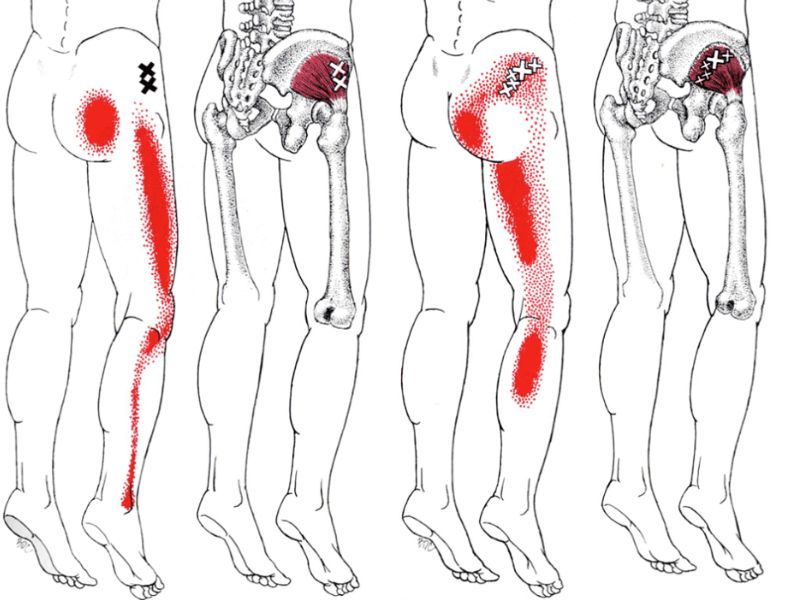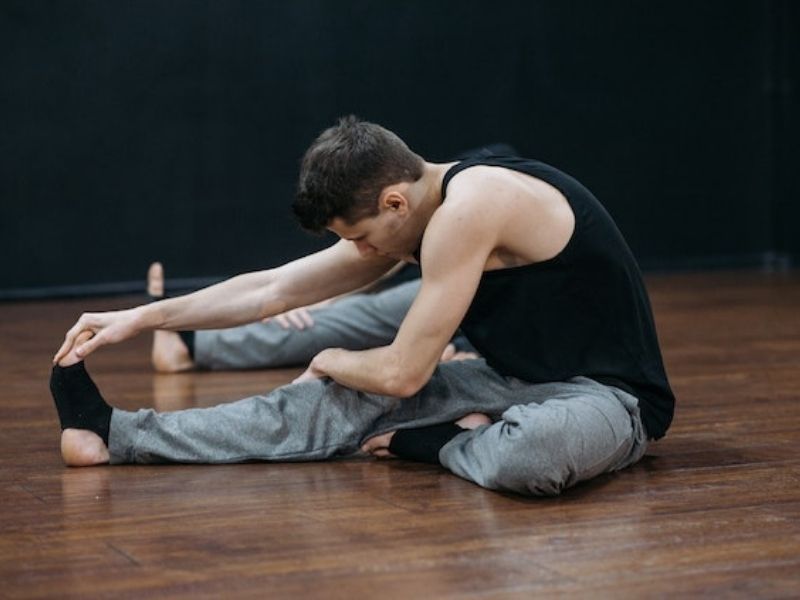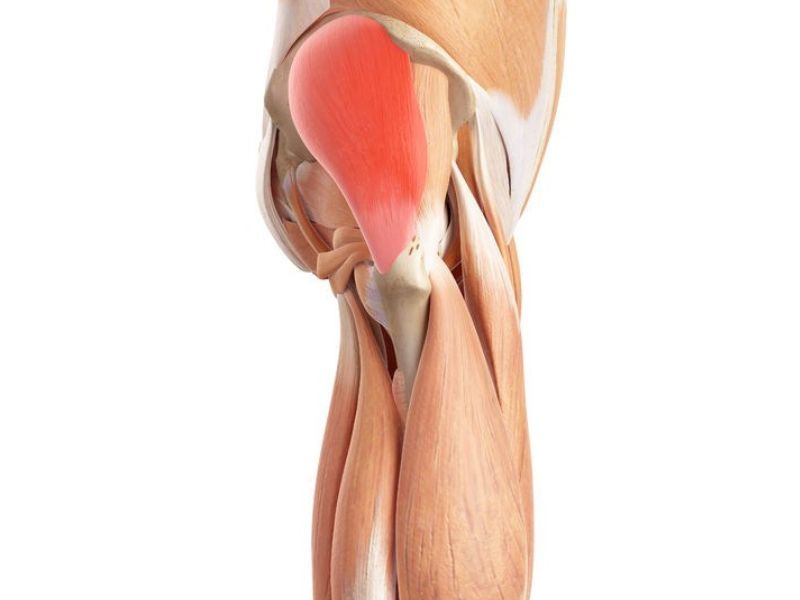Gluteus Minimus Trigger Points | Pain, Symptoms, and Finding Relief

Table of Contents
- - Glute Minimus Anatomy And Function
- - Origin and Insertion
- - Action and Synergistic Muscles
- - Innervation
- - Glute Minimus Trigger Point Locations
- - Signs and Symptoms
- - Differential Diagnosis
- - What Causes Gluteus Minimus Trigger Points?
- - Gluteus Minimus Trigger Point Pain Relief
- - How To Stretch The Glute Minimus For Trigger Point Relief
Are you struggling with unexplained hip or lower back pain that radiates down your leg?
You might be dealing with gluteus minimus trigger points, a common but often overlooked source of discomfort. These trigger points can mimic conditions like sciatica, making them tricky to diagnose and treat.
In this comprehensive guide, we’ll run through the anatomy, function, and common symptoms associated with gluteus minimus trigger points.
We’ll also provide actionable advice on self-massage techniques and stretching exercises to help you find relief. Whether you’re a healthcare professional or someone dealing with chronic pain, this article offers expert insights and practical solutions to help you understand and manage this condition effectively.
Glute Minimus Anatomy And Function
The gluteus minimus is one of the three major gluteal muscles that make up the glute group, along with the gluteus maximus and gluteus medius. It’s not just the smallest but also the deepest of the three, featuring a unique fan-shaped structure.
The anterior fibers of the muscle are slightly thicker than the posterior ones. This muscle plays a pivotal role in hip stabilization and movement, particularly in keeping the pelvis level during activities like walking and standing on one leg.
Origin and Insertion
The gluteus minimus originates from the external surface of the ilium, specifically between the anterior and inferior gluteal lines.
It inserts into the anterior border of the greater trochanter of the femur, serving as a critical point for thigh movement.
Action and Synergistic Muscles
– Abduction of the hip (moving the leg away from the midline)
– Medial rotation of the thigh
– Helps in hip stabilization, especially when the opposite leg is lifted off the ground
The gluteus minimus works synergistically with the gluteus medius and tensor fasciae latae during these movements. Conversely, muscles like the adductor magnus oppose the gluteus minimus during abduction, while the piriformis and gluteus maximus oppose it during medial rotation.
Innervation
The gluteus minimus is innervated by the superior gluteal nerve, which arises from the lumbar spinal nerves L4, L5, and S1.
Glute Minimus Trigger Point Locations

Signs and Symptoms
Localized Pain: A specific, tender area in the muscle itself may be due to a glute minimus trigger point.
Referred Pain Pattern: Pain can radiate down the leg, often mimicking sciatica (called pseudosciatica). It can also refer pain to the lower back and contribute to hip pain.
Limited Range of Motion: Difficulty in hip abduction or medial rotation.
Limping or Altered Gait: The pain and muscle tightness can affect walking patterns.
Pain When Sitting: Discomfort or pain when sitting for extended periods, especially on hard surfaces.
Night Pain: Some people experience increased pain at night, which can interfere with sleep.
Muscle Weakness: The affected muscle may feel weaker than usual, affecting balance and stability.
Tightness and Stiffness: A general feeling of tightness or stiffness in the hip area.
Differential Diagnosis
Trigger points in the gluteus minimus can often present symptoms that are easily confused with other medical conditions, complicating diagnosis and treatment. For instance, the radiating leg pain commonly associated with gluteus minimus trigger points can mimic the symptoms of sciatica.
Similarly, the referred pain to the lower back might be mistaken for lumbar spine issues or even sacroiliac joint dysfunction. The condition can also resemble hip bursitis, piriformis syndrome, or iliotibial band syndrome (ITBS), all of which cause hip pain and thigh region.
In some cases, the symptoms might even be attributed to more serious conditions like a herniated disc or osteoarthritis of the hip.
What Causes Gluteus Minimus Trigger Points?
Trigger points in the gluteus minimus muscle can be a significant source of hip and lower back pain, often mistaken for conditions like sciatica or lumbar spine issues. These painful knots can develop for a myriad of reasons, making them a common concern for those dealing with chronic pain.
Factors such as poor posture from prolonged sitting, overuse from activities like running or cycling, and muscle imbalances can all contribute to the formation of these trigger points. Additionally, direct trauma, sedentary lifestyles, and even improper footwear can exacerbate the issue.
Psychological stress and underlying medical conditions like arthritis or lumbar disc problems can also be culprits. As we age, the susceptibility to developing trigger points in the gluteus minimus increases, making it a relevant issue across multiple age groups.
Understanding the root causes of these trigger points is crucial for effective treatment and long-term relief.
Gluteus Minimus Trigger Point Pain Relief
Self Massage Using A Massage Ball
- Identify the Trigger Point: Refer to an illustration of the gluteus minimus muscle to locate where the trigger points are. They are usually indicated by a black dot, and the red referred pattern often goes down the back or the side of the leg.
- Positioning: Lay on your side on a flat surface.
- Apply Pressure: Place the 5-inch diameter fit ball under your gluteus minimus, specifically way up toward the hip crest where it meets your waist.
- Initial Compression: Raise your body slightly to apply pressure on the fit ball. Hold this position for 10 to 15 seconds, keeping the bottom leg relaxed.
- Adjust and Hold: Use your top leg to scooch your body upward. Look for any areas of pain or discomfort. Hold the position.
- Regulate Pressure: If the pressure feels too intense, you can use your arms to lift some of your body weight off the ball, move a bit, regroup, and then reapply pressure.
- Repeat: Scooch up again and continue to apply pressure on different potential trigger points.
How To Stretch The Glute Minimus For Trigger Point Relief
Stretch 1: Seated Forward Bend Glute Minimus Stretch

Steps:
- Positioning: Sit on the floor with your legs extended.
- Leg Placement: Bring your right leg in front of you, keeping it bent. Extend your left leg straight behind you.
- Body Alignment: Maintain a flat back.
- The Stretch: Gently lean your upper body over your bent right leg.
- Hold: Hold the stretch for about 15 to 20 seconds. This muscle group can be very tight, so go easy on the stretch.
- Repeat: Perform the stretch again for another 15 to 20 seconds.
- Switch Sides: Now switch legs and repeat the stretch on the other side.
Stretch 2: Supine Glute Minimus Stretch

Steps:
- Positioning: Lie on your back on the floor with your knees bent and arms down by your sides.
- Leg Placement: Place your right ankle on top of your left knee.
- The Stretch: Bring your left knee up towards your chest.
- Hand Placement: Interlace your hands around the thigh of your left leg.
- Pull: Gently pull both legs towards your chest until you feel a stretch in the right hip.
- Hold: Hold the stretch for about 15 to 20 seconds.
- Repeat: Perform the stretch again for another 15 to 20 seconds.
- Switch Sides: Now switch legs and repeat the stretch on the other side.
Sam Visnic
I’ve spent my life studying the fundamental aspects of human health with a focus on movement and clinical massage therapy. In a world of specialists, surgical procedures, drugs and quick fix remedies, I’m committed to finding and developing strategies that help people stuck at the “gap”. Over the last 20 years I’ve studied dozens of systems and methodologies for uncovering the root cause of aches and pains, along with postural and movement issues. Pain science, the art and science of hands-on soft tissue massage techniques, myofascial release, and coaching movement is essential in my practice. Integrating different methods but above all deciphering WHEN to use different techniques with different people and situations, along with integration of movements that people want to be able to do again is the key to long term success with my incredible track record with clients. Understanding the various elements that contribute to conditions and the power of communication and education makes my Release Muscle Therapy program separate from other hands-on therapy approaches.
Blogs You May Be Interested In
Categories
-
Deep Gluteal Pain Syndrome
-
Deltoids
-
Fallbrook
-
Foam Rolling
-
Glutes
-
Hamstrings
-
Hypnosis For Pain
-
Lats
-
Levator Scapulae
-
Lifestyle
-
Massage Therapy
-
Mobility
-
Movement and Exercise
-
Murrieta
-
Muscles
-
Nutrition
-
Obliques
-
Pain
-
Pectorals
-
Piriformis
-
Plantar Fasciitis
-
Product Review
-
Psoas
-
Quadratus Lumborum
-
Quadriceps
-
Rhomboids
-
Serratus Anterior
-
SI Joint
-
Sternocleidomastoid
-
Stretching
-
Subscapularis
-
Temecula
-
TMJ
-
Trapezius
-
Uncategorized
















